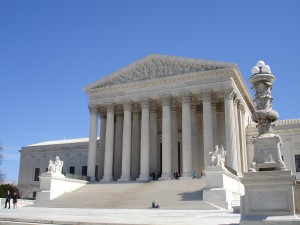
Today, the U.S. Supreme Court handed down three decisions: Astrue v. Capato, Taniguchi v. Kan Pacific Saipan, Ltd., and Holder v. Martinez Gutierrez. In both Capato and Martinez Gutierrez, the Court relied on the doctrine known as Chevron deference in reaching its decision.
Chevron Deference Explained
Chevron deference is a principle of administrative law requiring courts to defer to interpretations of statutes made by those government agencies charged with enforcing them, unless such interpretations are unreasonable. The principle is named for the 1984 Supreme Court case Chevron U.S.A., Inc. v. Natural Resources Defense Council, Inc., which involved a dispute over the Environmental Protection Agency’s interpretation of a provision of the Clean Air Act Amendments of 1977. Under Chevron, even if a court finds that another interpretation is reasonable, or even better than the agency’s interpretation, it must defer to the agency’s reasonable interpretation.
Reasonableness in part turns on whether the statute unambiguously addresses the issue. If it does, then the unambiguous meaning controls. If the statute is ambiguous, then the court asks whether the agency’s interpretation of the ambiguous provision is based on a permissible construction of the statute. A permissible construction is one that is not “arbitrary, capricious, or manifestly contrary to the statute.” In other words, it is a very low threshold of deference.
Astrue v. Capato: The Social Security Administration Defines “Children”
In Astrue v. Capato, one of the decisions the Supreme Court released today, the Court unanimously held that the Social Security Administration’s interpretation of the Social Security Act was entitled to Chevron deference and reversed the decision of the appeals court.
That case involved an interpretation of whether “child” under the Social Security Act included a child conceived through in vitro fertilization after the husband’s death. The Court found that the SSA’s interpretation, which excluded such children, was better than the interpretation by the appeals court and further, that the appeals court should have given Chevron deference to the SSA’s interpretation even if there were other reasonable interpretations. (Joanna Grossman, a Justia columnist and professor of law at Hofstra University, has written a two-part series of columns addressing the legal issues inherent in posthumously conceived children: Part 1 and Part 2 on Justia’s Verdict.)
Holder v. Martinez Gutierrez: The Board of Immigration Appeals Interprets Imputation Requirements
In today’s second case involving a decision by an administrative agency, Holder v. Martinez Gutierrez, the Supreme Court held that the Board of Immigration Appeals (BIA) reasonably interpreted an immigration statute, 8 U.S.C. § 1229b(a), as requiring a noncitizen child to meet lawful permanent resident (LPR) requirements independently, rather than through imputation by the parents’ residence or LPR status.
Applying Chevron, the Court considered first whether the statute was ambiguous. Finding it so, it then looked to whether the agency’s interpretation of the statute was reasonable. Justice Kagan, writing for a unanimous Court, found that the BIA’s interpretation was “based on a permissible construction of the statute” and thus entitled to deference.
As today’s decisions illustrate, judicial deference to administrative agencies is alive and well. Although the American public’s faith in the Supreme Court appears to be diminishing, these decisions affirm that at least one aspect of our system of checks and balances is quite strong.
